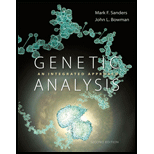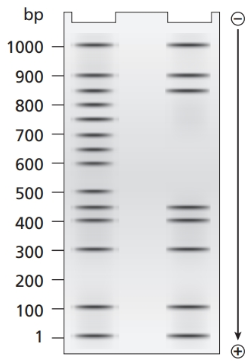
Concept explainers
A

a. What length of DNA is bound by the transcriptional proteins? Explain how the gel results support this interpretation.
b. Draw a diagram of this DNA fragment bound by the transcriptional proteins, showing the approximate position of proteins along the fragment. Use the illustration style seen in Research Technique
c. Explain the role of DNase I.
Want to see the full answer?
Check out a sample textbook solution
Chapter 8 Solutions
Genetic Analysis: An Integrated Approach (2nd Edition)
- Give Detailed Solution with explanation (no need Handwritten)arrow_forwardThe cellulase gene of Bacillus licheniformis was successfully cloned into the pET21a vector and expressed in Escherichia coli BL21. The pET21a vector consists of ampicillin resistant gene. To screen for the successful transformants, E. coli BL21 was cultivated on LB agar containing ampicillin (100 pg/mL) and 0.5% (w/v) carboxymethylcellulose, and incubated at 37 0C for 6 hours. After that the agar plate was stained with Congo red solution for 15 minutes and washed twice with sodium chloride solution and the observation is as shown in Figure 3. Answer the following: (i.) Briefly explain why ampicillin was added to the LB agar. (ii) Indicate the function of carboxymethylcellulose in the LB agar. (iii) Conclude how the researchers were able to identify the E. coli BL21 that carried the cellulase gene.arrow_forwardExpressing genes encoding a particular protein’s subunits from a plasmid in E. coli cells (volume of 1 cell = 0.5 um3) results in 1 gram of this protein when the E. coli cells reach a density of 2 x 109 cells/mL in a culture volume of 1.0L. Is this possible? Why or why not?.arrow_forward
- Below is an EMSA showing four different reactions, A-D. In each tube there is some combination of labelled DNA probe, Protein X (the protein you are studying), and an antibody for Protein X. Identify which combination of components are found in each of the four reactions and explain how you determined that based on the molecular interactions being studied and your knowledge of gel electrophoresis. It is possible that multiple lanes have the same component(s). A B C D EMSAarrow_forwardIn Northern blot analysis, mRNA samples from tissues are bound to a labeled DNA probe that is complementary to the mRNA, and run on a gel to be visualized. The protein tropomyosin is known to be present in both brain and liver. When brain and liver tissue were assayed for the presence of tropomyosin mature mRNA, bands of two different sizes were seen. Tropomyosin gene diagram (3000 bp total): Shown in attatched image If the band on the Northern blot for mRNA isolated from liver tissue is 2580 bp, whereas from brain tissue the band is 2250 bp, what is most likely? a)The two mRNAs are made from different tropomyosin DNA sequences. b)Exon 2 is alternatively spliced out of the brain mRNA. c)Introns 1 and 2 are spliced out of the brain transcript but not the liver transcript. d)Exons 1 and 3 are spliced out of the brain transcript but not the liver transcript. e)Exon 2 is alternatively spliced out of the liver mRNA.arrow_forwardHow much 340bp insert DNA should be added to a ligation in which 50ng of 4.3kb vector will be used? The desired vector: insert molar ratio needs to be 1:3.arrow_forward
- A cloned Bam HI DNA fragment, 3.0 kb long, was isolated in preparation for sequence determination. First, a map of restriction endonuclease cleavage sites had to be prepared. Cleavage by each of the indicated enzymes generated fragments of the sizes shown on the three agarose electrophoresis gel figures below; the gels are running from top to bottom. On the diagram below those, show the relative positions of EcoR I and Hpa II cleavage sites and the distances (in kb) between them. Explain your reasoning – is your placement of the cleavage sites the only one that will work?arrow_forwardAnalysis of a 49kDA protein is aimed with a western blot technique. For this purpose, "whole cell extract" was obtained from biopsy samples taken from three different individuals, and when their spectrophotometric measurements were made, their concentrations were determined to be 40 µg/µL, 50 µg/µL, and 100 µg/µL for three samples, respectively. At the beginning of the experiment, 200 µg of protein is loaded into each gel well by using a ready 5x loading solution containing SDS and β-mercapta-ethanol together with glycerol and methylene blue dye. a) If loading will be done in a volume of 20µL, then how is the preparation of the samples before loading?b) Considering the loading content given above, what can be said about whether this PAGE is "non-denaturing" or "denaturing". Justify taking into account the loading solution content.arrow_forwardA 2.0kb bacterial plasmid ‘BS1030’ is digested with the restriction endonuclease Sau3A; the plasmid map is depicted in the diagram below and the Sau3A (S) restriction sites are indicated. Which of the following DNA fragments do you expect to see on an agarose gel when you run Sau3A-digested plasmid ‘BS1030’ DNA? a. 250 bp, 450 bp, 550 bp, 1.1 kb, 1.5 kb and 2.0 kb b. 2.0kb c. 250 bp, 400 bp, 450 bp, 500 bp and 550 bp d. 100 bp, 200 bp, 250 bp, 400 bp, 500 bp and 550 bparrow_forward
- Please express the following in detailarrow_forwardClone number in this case is number 196 which is shown in the images. State whether a BamHI site has been re-created at the forward- and the reverse-end junctions of the human DNA with the plasmid vector band sizes are shown in one of the images. (0.5, 1, 2, 3, 4, 5, 6, 8, 10kb)arrow_forwardDuring agarose gel electrophoresis, why does DNA move through the gel when electric current is applied? because DNA is negatively charged because a charged chemical from the loading buffer is bound to the DNA because DNA is positively charged because DNA absorbs electricityarrow_forward
 Human Anatomy & Physiology (11th Edition)BiologyISBN:9780134580999Author:Elaine N. Marieb, Katja N. HoehnPublisher:PEARSON
Human Anatomy & Physiology (11th Edition)BiologyISBN:9780134580999Author:Elaine N. Marieb, Katja N. HoehnPublisher:PEARSON Biology 2eBiologyISBN:9781947172517Author:Matthew Douglas, Jung Choi, Mary Ann ClarkPublisher:OpenStax
Biology 2eBiologyISBN:9781947172517Author:Matthew Douglas, Jung Choi, Mary Ann ClarkPublisher:OpenStax Anatomy & PhysiologyBiologyISBN:9781259398629Author:McKinley, Michael P., O'loughlin, Valerie Dean, Bidle, Theresa StouterPublisher:Mcgraw Hill Education,
Anatomy & PhysiologyBiologyISBN:9781259398629Author:McKinley, Michael P., O'loughlin, Valerie Dean, Bidle, Theresa StouterPublisher:Mcgraw Hill Education, Molecular Biology of the Cell (Sixth Edition)BiologyISBN:9780815344322Author:Bruce Alberts, Alexander D. Johnson, Julian Lewis, David Morgan, Martin Raff, Keith Roberts, Peter WalterPublisher:W. W. Norton & Company
Molecular Biology of the Cell (Sixth Edition)BiologyISBN:9780815344322Author:Bruce Alberts, Alexander D. Johnson, Julian Lewis, David Morgan, Martin Raff, Keith Roberts, Peter WalterPublisher:W. W. Norton & Company Laboratory Manual For Human Anatomy & PhysiologyBiologyISBN:9781260159363Author:Martin, Terry R., Prentice-craver, CynthiaPublisher:McGraw-Hill Publishing Co.
Laboratory Manual For Human Anatomy & PhysiologyBiologyISBN:9781260159363Author:Martin, Terry R., Prentice-craver, CynthiaPublisher:McGraw-Hill Publishing Co. Inquiry Into Life (16th Edition)BiologyISBN:9781260231700Author:Sylvia S. Mader, Michael WindelspechtPublisher:McGraw Hill Education
Inquiry Into Life (16th Edition)BiologyISBN:9781260231700Author:Sylvia S. Mader, Michael WindelspechtPublisher:McGraw Hill Education





